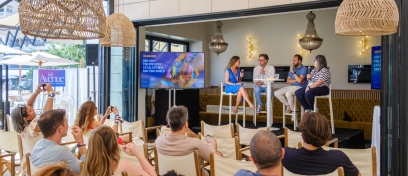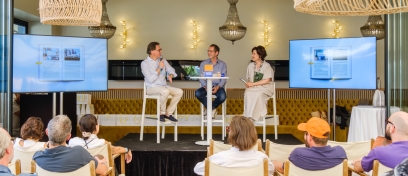For brands
In 'plane' sight: how a new virtual reality test tracks the consumer gaze at the airport
Unprecedented insight
Eye-tracking consultancy Tobii Pro argues that “our gaze is our most developed sense, revealing the things that catch our attention, drive our behaviour and influence our decision making, without bias.”If we accept this, then knowing what catches consumers’ eyes in premium advertising environments such as airports is vital for brands. JCDecaux, working with Tobii Pro and research consultant Spinview, set out to uncover what air passengers are looking at as they wait for a flight.
JCDecaux Airport UK created a 360-degree virtual reality airport environment based on Heathrow Terminal 5 to measure travellers’ engagement with adverts displayed on digital screens – achieving an unprecedented level of immersion into passenger mindsets. The new study builds on eye-tracking research initially carried out by JCDecaux 15 years ago, and complements the recent JCDecaux Airport studies The Changing Face of Travel and Airports: Open for Business.
The 40 participants were selected based on typical airport demographics, with a 50/50 gender split. The majority were aged from 18-64. The researchers did not make them aware of the advertising focus of the study.
Participants wore a headset that guided them along different versions of a pre-determined route through the terminal. They viewed a mixture of creative executions on the screens – some standard, and some dynamic versions for the same brands.
A camera in the headset captured images of participants’ eyes, which showed the reflections of the light source; with this information, the researchers measured the direction of each individual’s gaze as they moved through the virtual airport.
To complement the eye-tracking component of the study, participants also responded to questionnaires that measured the impact of the brands advertised in the airport and gauged participants’ opinion of the general role of adverts in the airport environment.
The case for airport advertising
The results of both aspects of the study make a compelling case for airport advertising.Using data gathered from the headsets, participants looked at an average of nearly 18 of the 23 screens displayed in the study – a hit rate of 77%. Engagement was also high, with participants spending around 15% of their time looking at the screens. On average, participants looked at individual adverts for just over two seconds – roughly in line with other advertising media.
Responses to the questionnaire backed up these findings. 71% of respondents recalled seeing the specific brands advertised, while 73% of respondents reported that advertising screens were one of the first three elements they could remember from the airport. Additionally, many considered advertising a positive addition to the overall airport experience.
“Our gaze is our most developed sense, revealing the things that catch our attention, drive our behaviour and influence our decision making, without bias.”Tobii Pro
Dynamic or static?
The study yielded a more complex picture regarding the respective benefits of dynamic and static screens in airports.The virtual reality experience showed that dynamic screens were 17% more engaging than static adverts, and the statements of several participants supported this. One respondent commented that they “liked the fact that it was all relevant to my upcoming trip to Beijing e.g. currency rate, time in Beijing.”
Perhaps unsurprisingly, the study found that adverts that made use of bright colour schemes and motion also gained greater engagement among study participants.
A new benchmark
This study has set a new technological benchmark for immersive market research in advertising. Linda Wade, CEO of Spinview, commented that “this study represents the gold standard in using virtual reality to produce highly accurate measurements of customer behaviour.”The powerful findings that the study has delivered will enable brands to make decisions based on even clearer and more reliable data on the human gaze and attention. Commenting on the research, Steve Cox, Marketing Director at JCDecaux Airport UK, concluded that “the learnings will enable us to service and advise our clients better, giving them key direction on how best to achieve a high impact and engaging creative campaign.”



